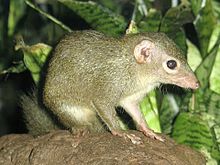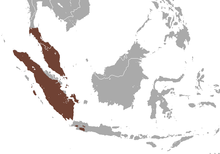Common treeshrew
| Common treeshrew | |
|---|---|

| |
| Scientific classification | |
| Domain: | Eukaryota |
| Kingdom: | Animalia |
| Phylum: | Chordata |
| Class: | Mammalia |
| Order: | Scandentia |
| Family: | Tupaiidae |
| Genus: | Tupaia |
| Species: | T. glis
|
| Binomial name | |
| Tupaia glis (Diard, 1820)
| |

| |
| Common treeshrew range | |
The common treeshrew (Tupaia glis) is a small mammal in the
Description
The common treeshrew is one of the largest among treeshrews. Average body length is between 16 and 21 cm (6.3 and 8.3 in), and average weight is around 190 g, with varying colours of reddish-brown, greyish or black upper parts and whitish belly. Its long, bushy tail is dark greyish-brown and almost reaches the length of the body. The paws are bare with sharp nails, and with a naked patch of skin above its long nose. Both sexes are similar. The animal has a head and body length of 13–21 cm and a tail length of 12–20 cm.[2] The common treeshrew usually has a white, pale stripe on each shoulder.
The two subspecies are T. g. longipes and T. g. salatana, with T. g. longipes being duller in color than T. g. salatana. The underparts of T. g. longipes are dull buff to reddish-buff, and the underside of the tail is greyish. The underparts and underside of the tail are dark reddish in T. g. salatana. Similar species are
Distribution and habitat
Common treeshrews occur south of about 10°N latitude in southern Thailand through mainland Malaysia and adjacent coastal islands to
Common treeshrews are probably present throughout the lowlands and hills up to 1,100 m (3,600 ft) in the Kelabit Highlands of Borneo. The subspecies T. g. longipes occurs in the north of Borneo, in Sarawak, and in East Kalimantan, including Sabah. The subspecies T. g. salatana occurs in the south of Rajang River and Kayan River in Borneo.[5]
Ecology and behavior
Common treeshrews are
They are very agile in climbing both large vertical tree trunks and bushes, and occasionally jump from stems of a young tree to that of another as much as 60 cm (24 in) away. Their climbing is concentrated in lower heights. They frequently
Juvenile males depart from their family's territory sooner than juvenile females.[6]
Reproduction
Both sexes of common treeshrews are sexually mature at the age of about three months. In captivity, females give birth for the first time at the age of about 4.5 mo, usually in February. A postpartum
From October to December, common treeshrews are reproductively inactive.[7] The mating season starts at the onset of the monsoon season in December and lasts until February. Oestrus and proestrus behavior is characterized by adult males pursuing adult females. Males emit chattering, and appear to be extremely excited. They also chase each other and fight. Females do not actively choose a partner among the male participants of chases. The dominant male gains access to females.[8]
In tropical rainforest habitats in West Malaysia, population density varies from two to five animals per hectare. Their annual breeding coincides with the abundance of invertebrates after the dry season. Their main reproductive period is between February and June, and their litter size is invariably two. Some females breed more than once a season, and the age at first pregnancy is seven months. The main period of emigration or mortality of young is during the breeding period or monsoon.[9]
Taxonomic status
The species was first described in February 1820 by the French explorers Pierre-Médard Diard and Alfred Duvaucel in their jointly written article "Sur une nouvelle espèce de Sorex — Sorex Glis", which is preceded by an illustration. They observed specimens in Penang and Singapore, and considered them a species of Sorex, and not as a new genus.[10] Between 1821 and 1940, several zoologists described the species from other areas. The species still retains many forms of uncertain rank and validity, and is pending a detailed study. Some forms were formerly considered synonyms of Tupaia glis; some were elevated to species level. Synonyms include:[3]
- ferruginea (Raffles, 1821)[11]
- press (Raffles, 1821)[11]
- hypochrysa (Thomas, 1895)
- chrysomalla (Miller, 1900)
- sordida (Miller, 1900)
- phaeura (Miller, 1902)
- castanea (Miller, 1903)
- pulonis (Miller, 1903)
- tephrura (Miller, 1903)
- demissa (Thomas, 1904)
- discolor (Lyon, 1906)
- batamana (Lyon, 1907)
- siaca (Lyon, 1908)
- lacernata (Thomas and Wroughton, 1909)
- raviana (Lyon, 1911)
- pemangilis (Lyon, 1911)
- wilkinsoni (Kloss, 1911)
- penangensis (Robinson and Kloss, 1911)
- longicauda (Kloss, 1911)
- obscura (Kloss, 1911)
- longicanda (Lyon, 1913)
- anambae (Lyon, 1913)
- redacta (Robinson, 1916)
- jacki (Robinson and Kloss, 1918)
- phoeniura (Thomas, 1923)
- siberu (Chasen and Kloss, 1928)
- cognate (Chasen, 1940)
- umbratilis (Chasen, 1940)
Threats
Common treeshrews are threatened due to deforestation and ensuing human activities in agriculture (for example, using trenchers to dig ditches), plantations, and commercial logging. Moreover, other pressures, such as hunting for food and sport, can create pressure to the species.[3]
As a model organism
Tupaia glis is used by researchers as animal models for human diseases because of their close relationship to
References
- ^ a b c d Sargis, E. & Kennerley, R. (2017). "Tupaia glis". IUCN Red List of Threatened Species. 2017: e.T111872341A123796056. Retrieved 26 January 2022.
- ISBN 978-1-906780-71-5.
- ^ OCLC 62265494.
- ^ Parr, J. W. K. (2003). Large Mammals of Thailand. Sarakadee Press, Bangkok, Thailand.
- ^ Payne J., Francis, C.M., Phillips, K. (1985) A Field Guide to the Mammals of Borneo, Malaysia. The Sabah Society. pp. 161–162.
- ^ a b c Nowak, R. (1999). Walker’s Mammals of the World (6th Ed.) Vol 1. Baltimore and London: The Johns Hopkins University Press. pp.245-246.
- ^ a b Kawamichi, T., Kawamichi, M. (1979) Spatial organization and territory of tree shrews (Tupaia glis) Archived 2011-07-23 at the Wayback Machine Animal Behaviour 27: 381–393
- ^ Kawamichi, T., Kawamichi, M. (1982) Social System and Independence of Offspring in Tree shrews Archived 2011-07-23 at the Wayback Machine Primates (23) 2: 189–205
- ^ Langham, NPE (1982) Ecology of the Common Tree Shrew, Tupaia glis in Peninsular Malaysia. Journal of Zoology. Vol. 197 (3): 323–344 Abstract Archived 2012-04-04 at the Wayback Machine
- ^ Diard, P.M., Duvaucel, A. (1820) "Sur une nouvelle espèce de Sorex — Sorex Glis". Asiatick researches, or, Transactions of the society instituted in Bengal, for inquiring into the history and antiquities, the arts, sciences, and literature of Asia, Volume 14. Bengal Military Orphans Press, 1822
- ^ a b Raffles, T. S. (1821). "Descriptive Catalogue of a Zoological Collection made on account of the Honourable East India Company, in the Island of Sumatra and its Vicinity, under the Direction of Sir Thomas Stamford Raffles, Lieutenant-Governor of Fort Marlborough; with additional Notices illustrative of the Natural History of those Countries". The Transactions of the Linnean Society of London. XIII. Linnean Society of London: 239–340.
- ^ Kuhn, H. and Schwaier, A. (1973). Implantation, early placentation, and the chronology of embryogenesis in Tupaia belangeri. Zeitschrift für Anatomie und Entwicklungsgeschichte 142(3): 315–340.

